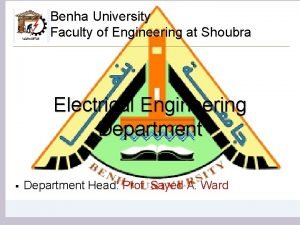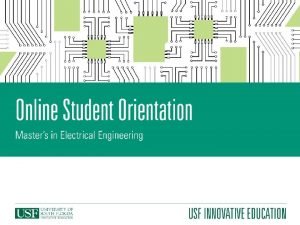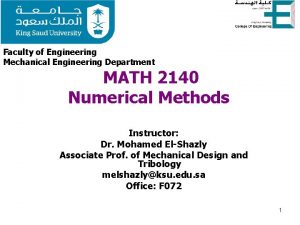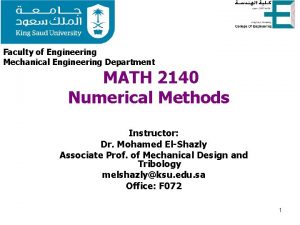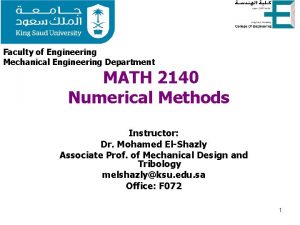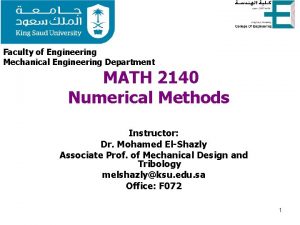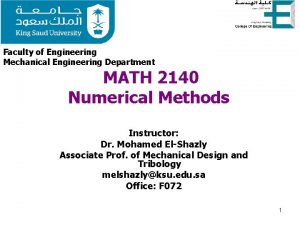Faculty of Engineering Mechanical Engineering Department MATH 2140














- Slides: 14

Faculty of Engineering Mechanical Engineering Department MATH 2140 Numerical Methods Instructor: Dr. Mohamed El-Shazly Associate Prof. of Mechanical Design and Tribology melshazly@ksu. edu. sa Office: F 072 1

Numerical Differentiation 2

1. BACKGROUND • • Differentiation gives a measure of the rate at which a quantity changes. Rates of change of quantities appear in many disciplines, especially science and engineering. One of the more fundamental of these rates is the relationship between position, velocity, and acceleration. If the position, x of an object that is moving along a straight line is known as a function of time, t, (the top curve in Fig. 8 -1): 3

The need for numerical differentiation • The function to be differentiated can be given as an analytical expression or as a set of discrete points (tabulated data). • When the function is given as a simple mathematical expression, the derivative can be determined analytically. • When analytical differentiation of the expression is difficult or not possible, numerical differentiation has to be used. • When the function is specified as a set of discrete points, differentiation is done by using a numerical method. • Numerical differentiation also plays an important role in some of the numerical methods used for solving differential equations, as shown 4

Approaches to numerical differentiation • Numerical differentiation is carried out on data that are specified as a set of discrete points • If there is a need to calculate the numerical derivative of a function that is given in an analytical form, then the differentiation is done by using discrete points of the function. This means that in all cases numerical integration is done by using the values of points. 5

• • For a given set of points, two approaches can be used to calculate a numerical approximation of the derivative at one of the points. One approach is to use a finite difference approximation for the derivative • The second approach is to approximate the points with an analytical expression that can be easily differentiated, and then to calculate the derivative by differentiating the analytical expression. The approximate analytical expression can be derived by using curve fitting. 6

2 - FINITE DIFFERENCE APPROXIMATION OF THE DERIVATIVE 7

Forward, backward, and central difference formulas for the first derivative 8

9

10

11

12

13

14
 Bart purnal
Bart purnal 2140 assignment
2140 assignment Faculty of mechanical engineering thammasat university
Faculty of mechanical engineering thammasat university Nit calicut chemistry department
Nit calicut chemistry department Actual mechanical advantage vs ideal mechanical advantage
Actual mechanical advantage vs ideal mechanical advantage Lee kong chian faculty of engineering and science
Lee kong chian faculty of engineering and science Faculty of civil engineering ctu prague
Faculty of civil engineering ctu prague Benha faculty of engineering
Benha faculty of engineering Faculty of engineering university of porto
Faculty of engineering university of porto Usf electrical engineering faculty
Usf electrical engineering faculty Civil engineering faculty
Civil engineering faculty St anns college chirala
St anns college chirala Faculty of electrical engineering
Faculty of electrical engineering Hijjawi faculty for engineering technology
Hijjawi faculty for engineering technology Ulfg2
Ulfg2

